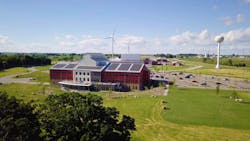DOE Announces Roadmap and $18 Million Investment to Improve Clean Energy Interconnection Processes
The U.S. Department of Energy (DOE) Interconnection Innovation e-Xchange (i2X) has released a new roadmap, the Distributed Energy Resource Interconnection Roadmap, which is expected to form shorter timelines and better outcomes for connecting clean energy resources to the distribution and sub-transmission grids.
The roadmap sets targets and strategies to improve interconnection processes and maintain reliability of the electric grid. DOE also announced $16 million in upcoming funding to support stakeholder engagement and technical assistance to adopt interconnection strategies on the distribution and transmission grids.
Additionally, DOE and the Joint Office of Energy and Transportation have announced $2.1 million for selected distribution utilities to pilot interconnection software solutions. DOE has also launched i2X Connect, an online platform to provide a space for interconnection stakeholders to exchange ideas and know-how.
Deployment of distributed energy resources (DERs) is increasing. The number of residential rooftop photovoltaic (PV) systems grew from 89,000 to 4.7 million from 2010 to 2023.
DER interconnection processes at the distribution and sub-transmission system levels are expected to progress to handle the growing volume of customer demand. This challenge requires solutions customized for local market conditions and availability of distributed energy resources.
The DOE roadmap provides the broad range of interconnection stakeholders, including utilities, state agencies, regulators, equipment manufacturers, consumer advocates, equity and energy justice groups, researchers, interconnection customers, and other actors, with 39 solutions organized around four goals:
- Increasing data access, transparency, and security
- Improving interconnection processes and timelines
- Promoting economic efficiency in interconnection
- Maintaining a reliable, resilient, and secure grid
The roadmap provides specific actions for the interconnection community to take in the next five years and beyond to address current DER interconnection challenges. It was developed through engagement with more than 1,000 interconnection stakeholders. The roadmap solutions offer strategies as compared to prescriptive fixes and are categorized to help stakeholders in different states or regions as well as identify the ones meeting their needs and priorities.
Moreover, the roadmap identifies five measurable targets for interconnection improvement by 2030. These include targets for shorter interconnection times and higher interconnection completion rates based on the size of the new system.
The roadmap targets aim for all 50 U.S. states, as well as the District of Columbia and U.S. territories, to have public, detailed, and current interconnection queue data available. Additionally, the roadmap sets goals for grid resilience and reliability: ensuring zero DER-related grid disturbances and decreasing the time to restore service after a power outage by 25%.
The roadmap supports DOE’s Transmission Interconnection Roadmap, published in April 2024, which identified solutions for challenges in transmission system interconnection.
DOE launched i2X Connect to accelerate implementation of the solutions identified in the two i2X roadmaps. The goal of the platform is to deploy solutions to improve interconnection processes through engagement and collaboration.
The DOE-moderated i2X Connect platform allows professionals representing their organizations to discuss key interconnection topics, including data transparency, equity and energy justice, grid engineering practices and standards, interconnection workforce and training, queue management and cost allocation, and electric vehicle grid integration.
DOE and the Joint Office of Energy and Transportation selected twelve projects across ten utilities whose collective service territories cover 24 states to receive $2.1 million through the i2X Innovative Queue Management Solutions (iQMS) for Clean Energy Interconnection and Energization Partnership Intermediary Agreement (PIA) program. Many distribution utilities do not have the tools and internal capabilities to manage the large volume of interconnection requests for mid-scale clean energy (100 kW to 5 MW) and flexible demand (e.g., EV charging) projects without delays or high costs.
The projects will fund distribution utilities to pilot innovative solutions for managing renewable energy and EV charging interconnection and energization queues. The selected distribution utilities are:
- American Electric Power and Appalachian Power (Tennessee, Virginia, and West Virginia): $200,000
- Duquesne Light Company (Pennsylvania): $200,000
- Eversource Energy (Connecticut): $200,000
- La Plata Electric Association (Colorado): $200,000
- LeapTran, Inc. and Guadalupe Valley Electric Cooperative (Texas): $200,000
- National Grid USA (Massachusetts and New York): $300,000
- NetMeterGO.com and Paducah Power Systems (Kentucky): $100,000
- Puget Sound Energy (Washington): $300,000
- Warren Rural Electric Co-Op Corporation (Kentucky): $200,000
- Xcel Energy Services (Colorado): $200,000
DOE also announced two upcoming interconnection funding opportunities expected to open for applications in spring 2025. The i2X Distributed Energy Resources Interconnection Solutions Collaboratives (DERISC) PIA will provide up to $8 million to support local, state, or regional collaborative teams to prioritize and tailor solutions in the DER Interconnection Roadmap. The i2X Accelerating Transmission System Interconnection Strategies (ATSIS) voucher program PIA willnprovide up to $8 million to offer specialized technical assistance to transmission owners and providers.
The assistance will help evaluate cost-saving interconnection solutions using grid-enhancing technologies and other advanced capabilities to fasten grid interconnection timelines and reduce overall cost.
The iQMS, DERISC, and ATSIS PIA programs are all administered by ENERGYWERX. This funding mechanism is made possible through the innovative Partnership Intermediary Agreement set up by DOE's Office of Technology Transitions.
